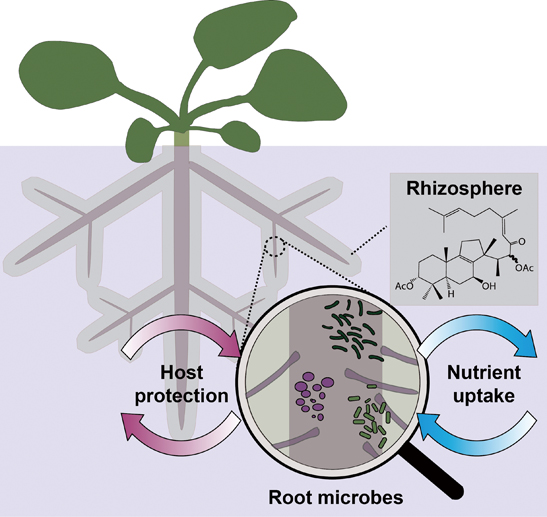By YAN Fusheng (Staff Reporter)
Plants, though passive and still as it appears, are considered to be quite active to engage with other living things, particularly in the root part that faces relatively more complicated surroundings. In a recent report in Science, researchers from the Institute of Genetics and Developmental Biology, Chinese Academy of Sciences and their cooperators from the John Innes Center, UK unraveled new evidence that plants can release certain root chemicals to mould soil microbes to its advantage.

The root of a small mustard plant called Arabidopsis thaliana secrets a mixture of both stimulative and selective metabolites to shape microbes in the rhizosphere, the zone of soil surrounding the roots that is influenced by the roots, to its own advantage, such as improved nutrient absorption and protection from pathogenic species. (Credit: YAN Fusheng)
Under the ever-lasting pressure of natural selection, the biological processes of all living things on this planet have been evolved, if not compelled, to consume their energy in a quite cost-effective way. There is barely room for plain waste. It is, however, an intriguing fact that ~20% of energy created by photosynthesis from the leaves above is consumed by the roots down in the soil to make exotic root metabolites. Could this be a waste?
The answer is certainly NO.
Scientists have formerly speculated that root exudates could help the host building up distinctive plant-beneficial microbial communities in the rhizosphere, the zone of soil surrounding the roots that is influenced by the roots, possibly selecting microbes that assist in plant growth or thwart pathogenic species. But scientists had yet to find direct evidence of such social engagement. The chemical driving force for such induced assembly of plant-beneficial microbes remains elusive.
Recently, an international team reported in Science that a small flowering mustard plant called Arabidopsis thaliana synthesizes certain root metabolites that repel or attract certain soil microbes to its own purpose. By doing this, the plant host can have improved nutrient absorption and protection from pathogens.
“These certain kind of root metabolites are previously-undiscovered chemicals belonging to a family of natural products called triterpenes, which are considered to influence one-half of the microbes that are drawn to this plant’s roots,” stated Anne Osbourn, a plant biologist at the John Innes Center who co-led the work with BAI Yang, a plant biologist at the Chinese Academy of Science.
Chemical Driving Force for Root Microbes
Osbourn’s team initially identified a group of genes that appeared to encode ecologically important metabolites in the Arabidopsis roots. To investigate the function of these molecules, BAI, who studies how plants interact with soil microbes, planted Arabidopsis on a Beijing farm, along with mutant plants disabled in making these chemicals. Considering most of the soil microbes are non-culturable in the lab, BAI’s team resorted to DNA sequencing to search genome signatures to identify the root microbes that had been attracted to these on-field planted Arabidopsis.
The genomic analysis shows that, when the Arabidopsis mutants fail to secrete these root chemicals, they tend to accumulate a different microbial community around the roots.
To test how these root metabolites could do directly to the root microbes, Osbourn’s lab synthesized some of the most abundant root chemicals and added them to the microbes that are isolated from the on-field planted Arabidopsis’s roots. Some of the triterpenes were showed to inhibit the growth of certain microbes; while other molecules promoted their growth, mirroring the finding from the on-field experiments. In the next step, the researchers seek to study the mechanism of the triterpene-microbe interactions in more detail to identify how exactly these molecules act on the molecular level.
A New Road to Greener Agriculture
So, root exudates, particularly some natural products, may act as the chemical driving force that shapes root microbial community to the plant host’s advantage. This new finding explains why plants convert so much energy to make these root-derived molecules and proves such investment is cost-effective. Such strategy could also be shared by other plants to recruit their distinctive soil microbes. Perhaps, this is also the reason why the root extractives from many Chinese herbs can impede certain types of human pathogenic microbes, due to the possibility that these human pathogens could share similar vulnerable spots with soil microbes.
More importantly, the newly-acquired knowledge concerning how plant genetic pathways can attract plant-beneficial soil microbes provides a new angle to modify the crops to enable a more sustainable agriculture with reduced input of chemical pesticides and fertilizers.

